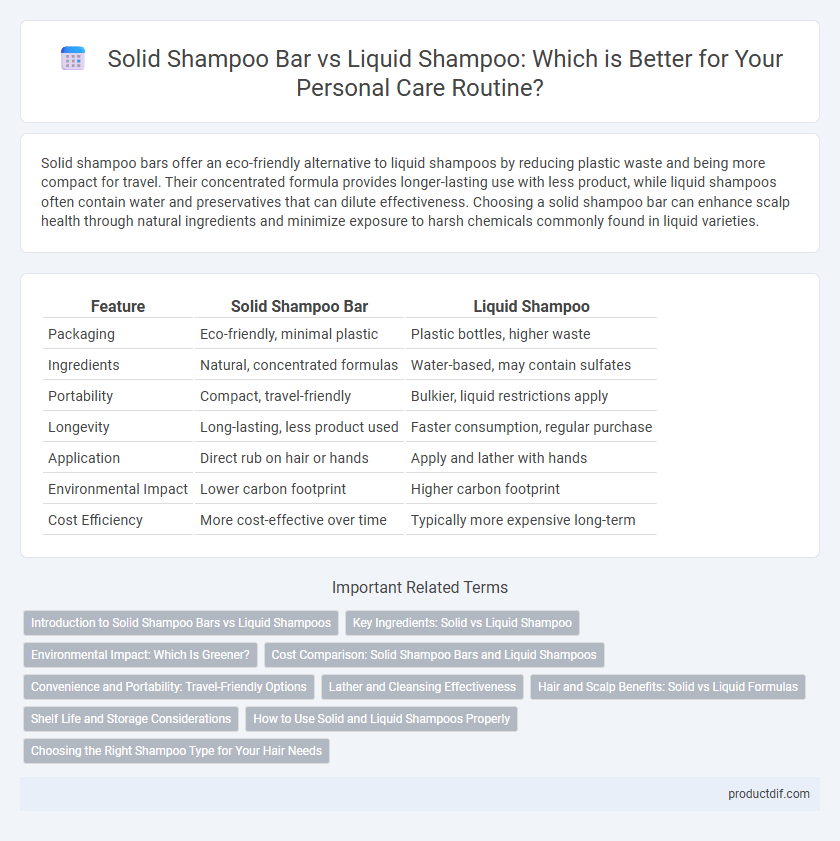Solid shampoo bars offer an eco-friendly alternative to liquid shampoos by reducing plastic waste and being more compact for travel. Their concentrated formula provides longer-lasting use with less product, while liquid shampoos often contain water and preservatives that can dilute effectiveness. Choosing a solid shampoo bar can enhance scalp health through natural ingredients and minimize exposure to harsh chemicals commonly found in liquid varieties.
Table of Comparison
| Feature | Solid Shampoo Bar | Liquid Shampoo |
|---|---|---|
| Packaging | Eco-friendly, minimal plastic | Plastic bottles, higher waste |
| Ingredients | Natural, concentrated formulas | Water-based, may contain sulfates |
| Portability | Compact, travel-friendly | Bulkier, liquid restrictions apply |
| Longevity | Long-lasting, less product used | Faster consumption, regular purchase |
| Application | Direct rub on hair or hands | Apply and lather with hands |
| Environmental Impact | Lower carbon footprint | Higher carbon footprint |
| Cost Efficiency | More cost-effective over time | Typically more expensive long-term |
Introduction to Solid Shampoo Bars vs Liquid Shampoos
Solid shampoo bars offer a concentrated formula free from water, making them eco-friendly with less packaging waste compared to liquid shampoos. Liquid shampoos typically contain water, synthetic additives, and preservatives, which increase their environmental footprint and packaging requirements. Choosing solid shampoo bars supports sustainable personal care routines by reducing plastic consumption and providing longer-lasting use per unit.
Key Ingredients: Solid vs Liquid Shampoo
Solid shampoo bars often contain concentrated natural ingredients like cocoa butter, shea butter, and essential oils, providing deep nourishment without synthetic additives. Liquid shampoos typically feature water-based formulas with surfactants such as sodium laureth sulfate and various chemical preservatives to maintain shelf life. The choice between solid and liquid shampoo depends on preferences for ingredient transparency, environmental impact, and hair type compatibility.
Environmental Impact: Which Is Greener?
Solid shampoo bars generate significantly less plastic waste compared to liquid shampoos by eliminating the need for plastic bottles, reducing landfill contribution and ocean pollution. They require less water both in formulation and packaging, lowering carbon emissions throughout production and transportation. Many solid bars are biodegradable and often packaged in recyclable or compostable materials, enhancing their eco-friendly profile over traditional liquid shampoos.
Cost Comparison: Solid Shampoo Bars and Liquid Shampoos
Solid shampoo bars typically offer a more cost-effective solution compared to liquid shampoos, as they last longer and require less packaging. A single shampoo bar can replace two to three bottles of liquid shampoo, reducing overall purchase frequency and waste. The concentrated formula in solid bars also means consumers use less product per wash, further enhancing their value for money.
Convenience and Portability: Travel-Friendly Options
Solid shampoo bars offer unmatched convenience and portability, making them ideal for travel due to their lightweight, compact design, and no risk of spills or TSA liquid restrictions. Liquid shampoos often require bulky, leak-proof containers, adding weight and taking up more space in luggage. Choosing a solid shampoo bar simplifies packing and streamlines personal care routines on the go.
Lather and Cleansing Effectiveness
Solid shampoo bars create a dense, creamy lather that effectively removes dirt and oils while minimizing water usage compared to liquid shampoos. The concentrated formula of shampoo bars often leads to better cleansing power with less residue, enhancing scalp health and hair strength. Liquid shampoos may produce more foam but tend to contain higher amounts of surfactants and preservatives, potentially causing scalp irritation over time.
Hair and Scalp Benefits: Solid vs Liquid Formulas
Solid shampoo bars often contain concentrated natural ingredients that gently cleanse the hair and scalp without stripping essential oils, promoting balanced moisture and reducing irritation. Liquid shampoos typically offer a wider variety of formulations targeting specific scalp conditions, such as dandruff or oily scalp, providing tailored benefits through added actives like salicylic acid or tea tree oil. Both forms support hair health, but solid bars emphasize sustainability and minimal chemical exposure while liquid shampoos focus on versatility and targeted scalp treatment.
Shelf Life and Storage Considerations
Solid shampoo bars typically offer a longer shelf life of up to 2-3 years compared to liquid shampoos, which generally last about 1-2 years due to their higher water content. Proper storage for solid shampoo bars involves keeping them dry and away from humidity to prevent premature softening or mold growth. Liquid shampoos require tightly sealed containers and cool, dark places to maintain efficacy and prevent bacterial contamination.
How to Use Solid and Liquid Shampoos Properly
To use solid shampoo bars properly, wet your hair and the bar, then rub the bar directly onto your scalp or lather it in your hands before massaging the foam through your hair, ensuring even coverage. Liquid shampoos require applying a small amount to wet hair, gently massaging the scalp to create lather, and rinsing thoroughly to avoid residue buildup. Both products perform best when followed by a proper rinse and are suited to different hair types and preferences, with solid bars offering concentrated formulas and liquid shampoos delivering easy application.
Choosing the Right Shampoo Type for Your Hair Needs
Solid shampoo bars offer concentrated formulas with fewer preservatives and reduced plastic waste, making them ideal for eco-conscious consumers with all hair types. Liquid shampoos provide customizable hydration levels and are typically better suited for oily or heavily styled hair due to their quick-absorbing properties. Selecting between solid and liquid shampoos depends on hair texture, scalp sensitivity, and environmental impact preferences.
solid shampoo bar vs liquid shampoo Infographic

 productdif.com
productdif.com